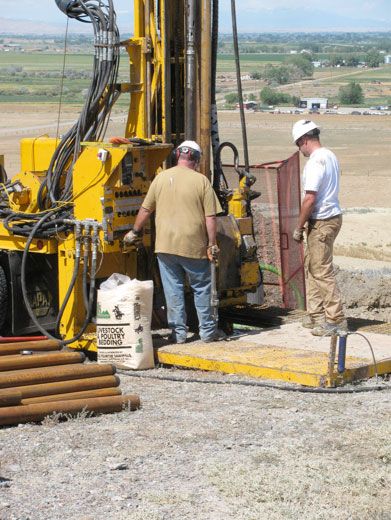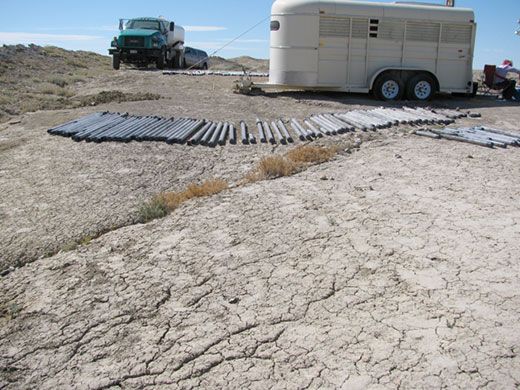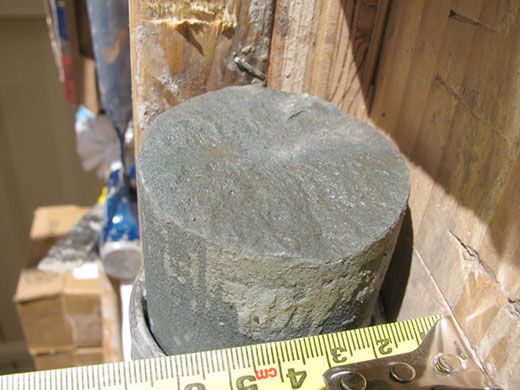Wyoming Paleontology Dispatch #7: The Excitement—and Dread—of Coring
Looking ridiculous, we rush around like inexperienced wait-staff in a busy restaurant
/https://tf-cmsv2-smithsonianmag-media.s3.amazonaws.com/filer/Wyoming-Dispatch-coring-materials-631.jpg)
The golden morning light still casts long shadows on the badlands when we arrive at the drill site at 6:30 on July 14. The rig’s motor is burbling and rumbling in the quiet morning. The driller, Ben, and his assistant, Cody, are moving quickly and surely as they prepare to lower the drill bit onto the big blue X where I marked the spot for the first core. Since we first began planning to drill these cores, I have thought about this moment with a combination of dread and excitement. Dread because I have never been involved in coring before and am completely reliant on the expertise of the drilling team—a far cry from the low-tech activity of my yearly fossil collecting. Excitement because we are about to take samples of rocks from hundreds of feet underground, unweathered rocks that may preserve chemical and microscopic fossils we have never before detected.
Doug and Anders call out to me: “Do you want to come see the ground-breaking?” I’m over to the rig like a shot. Ben moves some controls on the drilling rig, the pipe starts to rotate, then advances, then begins to cut through the surface dirt and pebbles. Ben drills down about five feet in just a few moments, halts, then pulls the core catcher and liner back to the surface. He swings the section of pipe containing the core out onto a sawhorse-like contraption, where Cody extracts the clear Lexan liner. It contains our first section of core—mostly just near-surface dirt of no scientific interest—but this is just the start. Over the next hours Ben and Cody repeat the process over and over again: drilling down about five feet at a time, then halting, dropping the overshot down the inside of the drill pipe so that it latches onto the assembly that contains the liner and the core, then pulling this assembly to the surface and removing the cylinder of rock in its liner. At first it seems so slow, but then I remember that we on the science team have a lot to do!
With each core section we have to find out from Ben how far down he has drilled, which he reports to us in feet and tenths of feet. (American drillers work in American units!) Cody hands over the latest section of core in its liner, and one of us picks up the 25-pound tube of rock and takes it back to the worktable we have set up, where we label the liner with a Sharpie, mark the “up” direction, cut the liner to fit the core section precisely, cap the ends of the liner (red for bottom, blue for top), tape the caps on, measure the length of the core section (in centimeters since we are scientists), weigh it, record a brief description of the type of rock we see through the liner, then drill holes through the plastic liner to drain the water we have used to lubricate the drilling. Then we have to clean the sediment off of the core catcher and return it to Cody. I know we must look ridiculous as we rush around, getting in one another’s way, perhaps like inexperienced wait-staff in a very busy restaurant. Within 20 minutes the cores are coming out of the hole faster than we greenhorns can deal with them, and Anders and Doug have to provide reinforcements and steadying words. Fortunately it doesn’t go at this pace all day. The deeper the hole gets, the longer it takes to retrieve each segment, so we have slightly longer periods during which to process each core.
The day heats up in its customary way, breaking 100 by 2 p.m. But we are used to the heat. We do experience problems, though. Sometimes Ben will drill down five feet, but recover only three feet of core in the liner. His expression lets me know he doesn’t like this. Perhaps the last two feet of core he drilled are still at the bottom of the hole? He sends the drill back down and drills another two feet, but comes up with four feet of core—the bottom two feet from the previous run, plus two feet from this run. But it isn’t always this simple—sometimes even after several runs we still haven’t recovered quite as much core as the length we drilled down. And the situation is made more confusing because we are constantly converting back and forth between metric and American measuring units. And it is 100 degrees. And we have now been working as fast as we can for eight hours. And we still have four hours to go. Finally I realize that I need to pause long enough to get a good drink of water—I’m inured to the heat, but I’m not used to the frantic pace and I have forgotten the first rule of badlands work, which is to stay hydrated.
As the heat of the day passes and the light lengthens again, we realize that we have finally established a rhythm of work. Each of us has a “specialty,” we stay out of one another’s way, and we get the cores processed about as fast as Ben and Cody are producing them. The work may be repetitive, and there isn’t the possibility of the dramatic fossil find that I get with my normal collecting, but there is a huge satisfaction in seeing the growing pile of Lexan tubes, each containing a core section. By the end of our shift, at 7 in the evening, we are down well over 100 feet, more than a quarter of our target depth. Ben and Cody are replaced by A.J. and Brandon, the night-shift drillers. Elizabeth, Aaron and Brady arrive to take over for the evening science shift. Anders is pulling a superhuman double shift—he has been here all day and will continue until 7 a.m. tomorrow. Doug and Guy and Allie and Johan and I are almost reluctant to leave—we have this process down now, and feel pretty good about the system we have refined. But it doesn’t take long for us to convince ourselves it is time for dinner and bed.
We have had a long day, recovered a lot of core and are confident that every section is properly labeled, oriented, described and measured. Even more important, we have seen rocks that have a lovely dark brown color, indicating they preserve a lot of organic material, material that may include the chemical fossils we are looking for. But we will have to wait for the lab analyses later this year to know for sure.
Back in Greybull, we have a quick, late dinner at Lisa’s Restaurant, and then head to bed. We will be up at 6 in order to get breakfast and be ready to relieve the night shift at 6:45 tomorrow morning.
Over the next three days our crew drills two holes, each 450 feet deep, and recovers essentially 100 percent of the rocks that we have drilled through. These are the first cores ever obtained of a terrestrial environment during the PETM. We have cored the same time interval at two sites quite close together so that we can increase the amount of rock from each stratigraphic level. We want a large volume of samples because we don’t know what the concentration of molecular fossils will be, and because we want to be able to preserve part of the cores as an archive that future scientists can work on. Who knows if there will ever again be funding to undertake this sort of coring operation. It has taken a total of four days of 24-hour work, and we are proud of our efforts and a little giddy with exhaustion.
And what does one do with 900 feet of core, divided into about 200 segments and weighing thousands of pounds altogether? No problem, apparently, because Tom Churchill arrives shortly after we are done, having driven the two hours from Powell in his barley truck. We all load the cores in the back, and Tom heads back to Powell where the cores will be unloaded into his shed and stored on racks built for beehives. Once again, it’s the Churchills to the rescue of the paleontologists.
Scott Wing is a research scientist and curator in the Smithsonian Institution’s Department of Paleobiology.
/https://tf-cmsv2-smithsonianmag-media.s3.amazonaws.com/accounts/headshot/SLW_photo_-James_Kegley_for_Smithsonian.jpg)



/https://tf-cmsv2-smithsonianmag-media.s3.amazonaws.com/accounts/headshot/SLW_photo_-James_Kegley_for_Smithsonian.jpg)